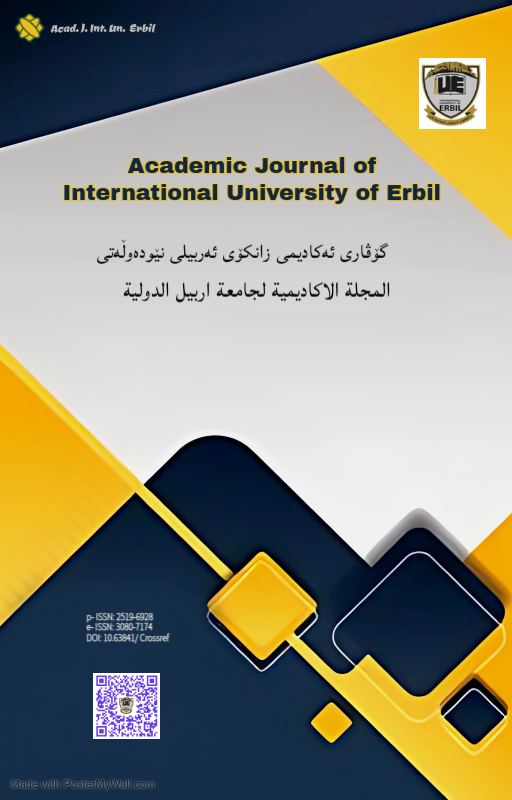The Transformative Impact of Artificial Intelligence (AI) on Enhancing Healthcare Systems in the Middle East
DOI:
https://doi.org/10.63841/iue12471Keywords:
Artificial Intelligence, Middle-East, AI Challenges, Healthcare System, Patient EducationAbstract
This review aims at discussing the possibilities of synergistically fostering AI technologies in the sphere of Middle Eastern healthcare. It shows vast value that fortifies AI in patient affairs, especially through chat bubbles such as Chabot’s disseminating crucial COVID information, virtual health record, teleconsultation, and health-oriented mobile applications significantly improving patient satisfaction and centered care. Nevertheless, the review also reports difficulties with inclusion of AI in the sphere of healthcare. The elements that include data privacy concerns, compliance matters, and demands for proper structures are established as important incantations of success. In addition, due to the qualitative and quantitative differences of the Middle Eastern society, economy, and culture, proper strategic concepts must be developed to enhance the social acceptance of AI solutions in the healthcare sector among HCWs and patients. Therefore, based on the analysis of the evidence discussed in this review, there is sufficient proof that AI is making perceptible and positive impacts on healthcare organization in the Middle East. The region is leading in the implementation of AI whereby the technology’s possibilities can be utilized in tackling the challenges that affect healthcare and the lives of the patients. Consequently, the Middle East has a progressive outlook to even more transformative Industry 4.0 adaptations and the advancement of health care with AI technology.
References
Ujager FS, Hamacha SR, Benjamin B. A comprehensive overview of artificial intelligence in healthcare. In: Advances in Computer and Electrical Engineering. IGI Global; 2023. p. 339–62.
Topol, E. (2019). Deep medicine: how artificial intelligence can make healthcare human again. Hachette UK.
Li, D., & Yang, Q. (2021). Artificial Intelligence and Its Applications. ACM Computing Surveys, 54(6), Article 114. doi:10.1145/3467789
Jewell, C., & Ng, A. (2019). Artificial intelligence: the new electricity. WIPO MAGAZINE, (3), 2-6.
DuBois, K. N. (2019). Deep medicine: how artificial intelligence can make healthcare human again. Perspectives on Science and Christian Faith, 71(3), 199-201.
Smuha, N. A. (2019). The EU approach to ethics guidelines for trustworthy artificial intelligence. Computer Law Review International, 20(4), 97-106.
Smit, K., Zoet, M., & van Meerten, J. (2020). A review of AI principles in practice.
Rajpurkar P, Chen E, Banerjee O, Topol EJ. AI in health and medicine. Nat Med. 2022 Jan;28(1):31–8.
Tran, B., Vu, G., Ha, G., Vuong, Q.-H., Ho, M.-T., Vuong, T.-T., La, V.-P., Ho, M.-T., Nghiem, K.-C., Nguyen, H., Latkin, C., Tam, W., Cheung, N.-M., Nguyen, H.-K., Ho, C., & Ho, R. (2019). Global evolution of research in artificial intelligence in health and medicine: A Bibliometric Study. Journal of Clinical Medicine, 8(3), 360.
Canadian Association of Radiologists White Paper on Artificial Intelligence in Radiology. Can. Assoc. Radiol. J. 2018, 69, 120–135.
Shaban-Nejad A, Michalowski M, Buckeridge DL. Health intelligence: how artificial intelligence transforms population and personalized health. Npj Digit Med. 2018 Oct 2;1(1):53, s41746-018-0058–9.
Odusami, M.; Maskeliunas, R.; Damaševiˇcius, R.; Krilaviˇcius, T. Analysis of Features of Alzheimer’s Disease: Detection of Early ¯ Stage from Functional Brain Changes in Magnetic Resonance Images Using a Finetuned ResNet18 Network. Diagnostics 2021, 11, 1071.
Svoboda, E. Artificial intelligence is improving the detection of lung cancer. Nature 2020, 587, S20–S22.
Bellemo, V.; Lim, G.; Rim, T.H.; Tan, G.S.W.; Cheung, C.Y.; Sadda, S.; He, M.; Tufail, A.; Lee, M.L.; Hsu, W.; et al. Artificial Intelligence Screening for Diabetic Retinopathy: The Real-World Emerging Application. Curr. Diab. Rep. 2019, 19, 72.
Jiang, F.; Jiang, Y.; Zhi, H.; Dong, Y.; Li, H.; Ma, S.; Wang, Y.; Dong, Q.; Shen, H.; Wang, Y. Artificial intelligence in healthcare: Past, present and future. Stroke Vasc. Neurol. 2017, 2, 230–243.
Filipp FV. Opportunities for artificial intelligence in advancing precision medicine. Curr Genet Med Rep [Internet]. 2019;7(4):208–13.
Senior, A.W.; Evans, R.; Jumper, J.; Kirkpatrick, J.; Sifre, L.; Green, T.; Qin, C.; Žídek, A.; Nelson, A.W.R.; Bridgland, A.; et al. Improved protein structure prediction using potentials from deep learning. Nature 2020, 577, 706–710.
Paul, D.; Sanap, G.; Shenoy, S.; Kalyane, D.; Kalia, K.; Tekade, R.K. Artificial intelligence in drug discovery and development. Drug Discov. Today 2021, 26, 80–93.
Siontis, K.C.; Noseworthy, P.A.; Attia, Z.I.; Friedman, P.A. Artificial intelligence-enhanced electrocardiography in cardiovascular disease management. Nat. Rev. Cardiol. 2021, 18, 465–478.
Hashimoto, D.A.; Rosman, G.; Rus, D.; Meireles, O.R. Artificial Intelligence in Surgery: Promises and Perils. Ann. Surg. 2018, 268, 70–76.
Zhou, X.Y.; Guo, Y.; Shen, M.; Yang, G.Z. Application of artificial intelligence in surgery. Front. Med. 2020, 14, 417–430.
Carriere, J.; Shafi, H.; Brehon, K.; Pohar Manhas, K.; Churchill, K.; Ho, C.; Tavakoli, M. Case report: Utilizing AI and NLP to assist with healthcare and rehabilitation during the COVID-19 pandemic. Front. Artif. Intell. 2021, 4, 613637.
Manickam P, Mariappan SA, Murugesan SM, Hansda S, Kaushik A, Shinde R, et al. Artificial Intelligence (AI) and Internet of Medical Things (IoMT) Assisted Biomedical Systems for Intelligent Healthcare. Biosensors. 2022 Jul 25;12(8):562.
Khatib, E., ZM, R., & Al-Nakeeb, A. (2021). The effect of AI on project and risk management in healthcare industry projects in the United Arab Emirates (UAE). Int. J. Appl. Eng. Res, 6(1).
Sakaguchi-Tang, D., Bosold, A., Choi, Y & Turner, A. (2017). Patient Portal Use and Experience Among Older Adults: Systematic Review. JMIR Medical Informatics, 5(4). DOI: 10.2196/medinform.8092.
Bloomfield, R., Polo-Wood, F., Mandel, J & Mandl, K. (2017). Opening the Duke Electronic Health Record to Apps: Implementing SMART on FHIR. International Journal of Medical Informatics, 99, 1-10.
Tavares, J & Oliveira, T. (2016). Electronic Health Record Patient Portal Adoption by Health Care Consumers: An Acceptance Model and Survey. Journal of Medical Internet Research, 18(3). DOI: 10.2196/jmir.5069.
Kakarash, Z. A., Abd, D. F., Al-Ani, M., Omar, G. A., & Mohammed, K. (2019). Biometric Iris recognition approach based on filtering techniques. Journal of Garmian University, 6(2), 360-368.
MOHAP (2019) MOHAP adopts Artificial Intelligence (AI) to reduce waiting time in emergency departments by using the smart healthcare operation centre “PaCE”. Available at: http://www.mohap.gov.ae/en/MediaCenter/News/Pages/2033.aspx (Accessed 31 March 2019).
Vanitha, D. D. . (2022). Comparative Analysis of Power switches MOFET and IGBT Used in Power Applications. International Journal on Recent Technologies in Mechanical and Electrical Engineering, 9(5), 01–09. https://doi.org/10.17762/ijrmee.v9i5.368
Natsheh, Essam, and Mohammed Jabed. “Implementing Artificial Intelligence-Based COVID-19 Chatbot in the Kingdom of Bahrain.” International Journal of Intelligent Systems and Applications in Engineering, vol. 10, no. 3, 30 Sept. 2022, pp. 10–17, ijisae.org/index.php/IJISAE/article/view/2131. Accessed 20 Aug. 2023.
Aljerian N, Arafat M, Aldhubib A, Almohaimeed I, Alsultan A, Alhosaini A, et al. Artificial Intelligence in Health care and its application in Saudi Arabia. ijirms. 2022 Nov 20;7(11):666–70.
Department of Health Informatics, College of Public Health and Health Informatics, University of Ha’il, Ha’il, Saudi Arabia, Alshammari MH. Electronic-health in Saudi Arabia: A review. Int j adv appl sci. 2021 Jun;8(6):1–10.
Abdullah RA-O, Fakieh BA-O (2020) Health Care Employees' Perceptions of the Use of Artificial Intelligence Applications: Survey Study 22: e17620.
Dabdoub, F., Colangelo, M., & Aljumah, M. (2022). Artificial intelligence in healthcare and biotechnology: a review of the Saudi experience. J Artif Intell Cloud Comput, 107, 26.
Shaban-Nejad A, Michalowski M, Buckeridge DL. Health intelligence: how artificial intelligence transforms population and personalized health. npj Digital Med. 2018 Oct 2;1(1):53, s41746-018-0058–9.
Alelyani M, Alamri S, Alqahtani MS, Musa A, Almater H, Alqahtani N, et al. Radiology Community Attitude in Saudi Arabia about the Applications of Artificial Intelligence in Radiology. Healthcare. 2021 Jul 1;9(7):834.
Briganti G, Le Moine O. Artificial Intelligence in Medicine: Today and Tomorrow. Front Med. 2020 Feb 5;7:27.
Liu CF, Chen ZC, Kuo SC, Lin TC. Does AI explainability affect physicians’ intention to use AI? International Journal of Medical Informatics. 2022 Dec;168:104884.
Huo W, Yuan X, Li X, Luo W, Xie J, Shi B. Increasing acceptance of medical AI: The role of medical staff participation in AI development. International Journal of Medical Informatics. 2023 Jul;175:105073.
Taie ES. Artificial intelligence as an innovative approach for investment in the future of healthcare in Egypt. CNS. 2020 Jun 21;8(3):1.
Li J, Zhang C, Li X, Zhang C. Patients’ emotional bonding with MHealth apps: An attachment perspective on patients’ use of MHealth applications. International Journal of Information Management. 2020 Apr;51:102054.
Swed S, Alibrahim H, Elkalagi NKH, Nasif MN, Rais MA, Nashwan AJ, et al. Knowledge, attitude, and practice of artificial intelligence among doctors and medical students in Syria: A cross-sectional online survey. Front Artif Intell. 2022 Sep 29;5:1011524.
Aburas, R., Najeeb, A., Baageel, L., & Mackey, T. K. (2018). The Syrian conflict: a case study of the challenges and acute need for medical humanitarian operations for women and children internally displaced persons. BMC medicine, 16(1), 1-6.
Chan, K. S., & Zary, N. (2019). Applications and challenges of implementing artificial intelligence in medical education: integrative review. JMIR medical education, 5(1), e13930.
Thrall, J. H., Li, X., Li, Q., Cruz, C., Do, S., Dreyer, K., & Brink, J. (2018). Artificial intelligence and machine learning in radiology: opportunities, challenges, pitfalls, and criteria for success. Journal of the American College of Radiology, 15(3), 504-508.
Reyes, M.; Meier, R.; Pereira, S.; Silva, C.A.; Dahlweid, F.-M.; von Tengg-Kobligk, H.; Summers, R.M.; Wiest, R. On the Interpretability of Artificial Intelligence in Radiology: Challenges and Opportunities. Radiol. Artif. Intell. 2020, 2, e190043.
Deep learning of HIV field-based rapid tests 27: 1165-1170.23. Thrall JH, Li X, Li Q, Cruz C, Do S et al. (2018) Artificial Intelligence and Machine Learning in Radiology: Opportunities, Challenges, Pitfalls, and Criteria for Success 15: 504-508.
Kakarash, Z. A., Ezat, H. S., Omar, S. A., & Ahmed, N. F. (2022). Time series forecasting based on support vector machine using particle swarm optimization. International Journal of Computing, 21(1), 76-88.
Kakarash, Z. A., Mardukhia, F., & Moradi, P. (2023). Multi-label feature selection using density-based graph clustering and ant colony optimization. Journal of Computational Design and Engineering, 10(1), 122-138.
Henshaw, D., Okawa, G., Ching, K., Garrido, T., Qian, H & Tsai, J. (2015). Access to Radiology Reports via an Online Patient Portal: Experiences of Referring Physicians and Patients. Journal of the American College of Radiology, 12(6), 582-586.













